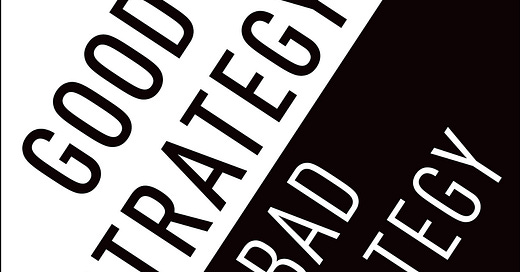The $150MN Investment That Changed Apple's Fate
Jobs was clear about Apple's turnaround strategy, but Rumelt fails to mention his incredible tactical awareness.
Implementing lessons from business non-fiction books can be hard. Glamorous case-studies from unrelated industries while entertaining can distract from the abstract principles at play. In this series of articles, I bring focus to these principles. I hope this simplification and my real-world perspective, helps you build habits and mindsets that help you grow professionally. TL;DR and quotes at the end.
Today, I discuss the first chapter of Richard Rumelt’s Good Strategy/Bad Strategy — The Difference And Why It Matters.
When Jobs rejoined Apple in the 90s, their stock had hit a 12 year low. Jobs not only turned Apple around but set it up for future dominance. Rumelt lauds Jobs’ clarity of thought. He retained only one product and consolidated distribution channels among many hard measures. Rumelt claims Jobs’ actions showed the signs of ‘Good Strategy’.
Principle 1
“Good strategy has coherence, coordinating actions policies, and resources so as to accomplish an important end”. Most organizations’ strategies don’t have this coherent approach but “multiple goals and initiatives that symbolize progress” instead.
Is that it? Coherence, coordination actions, policies, and resources?
Jobs raised $150MN from Apple’s competitor, Microsoft. Yep, Microsoft. This gave him financial leeway to take hard measures. Rumelt does mentions this but underplays its significance. If Apple failed, Microsoft would have faced anti-trust litigation from the DoJ. Jobs recognised the domino effect of an Apple failure and took advantage of it. This was tactical genius.
Here lies the other lesson from this book’s first chapter. As professionals, we must strive to build this level of tactical awareness for ourselves. We must keep up-to-date with competition, substitutes, partners, customers, technology, and regulation. This awareness will help us make and execute strategies that are coherent and have coordination. Rumelt, to his credit does dedicate an entire chapter to research later in the book.
Rumelt then draws on the Gulf War. Iraq had invaded Kuwait, a key US ally. Commentators and internal sources had written off the coalition’s chances of driving out well fortified Iraqi forces. And yet to everyone’s surprise, the US-led coalition succeeded. Rumelt believes this sense of surprise is significant.
Principle 2
“Good strategy is unexpected….most complex organizations spread rather than concentrate resources, acting to placate and pay off internal and external interests.”
Ok, good strategy is unexpected. So what?
Rumelt rightly points out a significant problem. Even if stakes are lower, management professionals face such internal obstacles all the time. Gen. Schwarzkopf, the leader of US and Coalition forces had to fend off many such ‘interests’. Schwarzkopf even sidelined King Fahd and Dick Cheney during planning. A king and a king-maker. Badass. But how? Gen. Schwarzkopf was a highly decorated general. He was credible. Rumelt doesn’t mention this at all . This credibility earned him the influence to reign in a literal king.
In my opinion, such credibility is carefully built or unwittingly accrued over a long career. To complement Rumelt’s valuable insight, I propose this: we need to be careful about managing our perceived credibility. Not a trivial task. We’ll probably need a book for just that. With credibility though managers can influence stakeholders and execute with team-wide coordination.
TL;DR
Jobs’ tactical awareness and Gen. Schwarzkopf’s credibility are traits (or skills) that us professionals too can build over the course of our careers. I propose that readers should find ways to improve their tactical awareness of the marketplace and manage their credibility to build strategies that have coherence, focus and alignment.
If you would like to continue reading, here’s the the next chapter’s summary.
Source
Rumelt, Richard.Good Strategy/Bad Strategy — The Difference And Why It Matters. Crown, 2011.







